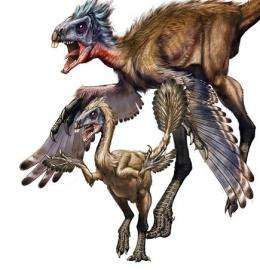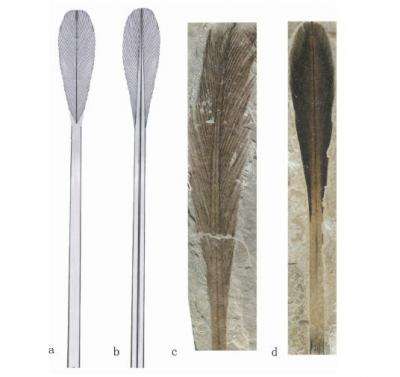April 30, 2010 report
Feather structures in maturing dinosaurs changed as they grew

(PhysOrg.com) -- Scientists from the Chinese Academy of Sciences in Beijing studying the feathers of the dinosaur Similicaudipteryx have found the feather structures changed as the animals matured, with the fossil of a smaller animal having feathers that were ribbon-like at the base with quills at the tips, and a larger dinosaur of the same species having quills the entire length of the forelimbs and tails.
Similicaudipteryx was a small therapod dinosaur that lived around 125 million years ago. The scientist leading the team of researchers, Xing Xu, a palaeontologist from the Institute of Vertebrate Paleontology and Paleoanthropology, has uncovered many feathered dinosaurs, but fossils of juvenile animals are scarce, so the discovery of two young of the same species in the western Liaoning province in China is an exciting one. Xu is confident about their classification as young of the Similicaudipteryx species because of analysis of their spines, hips and skulls, and the fact that some of their vertebrae are not yet completely fused.
The smaller dinosaur is around the size of a pigeon and is presumed to be younger, and its back and hip are covered with downy feathers. It has 10 pennaceous, or contour, feathers on its forelimb and 11 larger feathers on its tail. The base of the feathers is ribbon-like with no central shaft but the tips resemble quills. The larger specimen is around the size of a goose and is presumably older, but its back, head and hip are still covered with down. It has 22 pennaceous feathers on its forelimb (10 primary and 12 secondary), and 12 or more pairs of feathers on the tail. In this specimen all the feathers are quill-like along their length, and they are all around the same length.

Together, the pair show how the feather structure of this dinosaur changed quite dramatically as the animals grew older. Xu said it was most likely that the animals moulted, replacing their ribbon-like feathers with larger, quill-like versions as they matured. They may also have grown secondary feathers as they aged, although it is possible the younger specimen had secondary feathers but they did not fossilize well. The change in relative sizes of the forelimb and tail feathers suggests the forelimb feathers increased in importance as the animal approached adulthood.
The feathers seen on the junior Similicaudipteryx (proximally ribbon-like pennaceous feathers or PRPFs) are similar to those found in other dinosaurs such as the confuciusornithids, but they are not found in modern birds. The change in feather structure is also not seen in today’s birds, which have the same feather structure throughout their lives once they have moulted their first downy feathers.
The findings are published online in the journal Nature.
More information: Exceptional dinosaur fossils show ontogenetic development of early feathers, Nature 464, 1338-1341 (29 April 2010) doi:10.1038/nature08965
© 2010 PhysOrg.com












.jpg)






